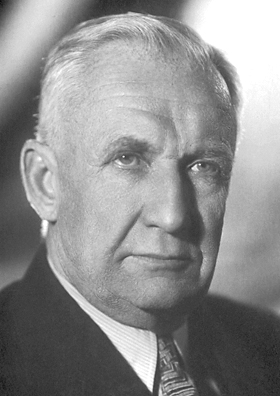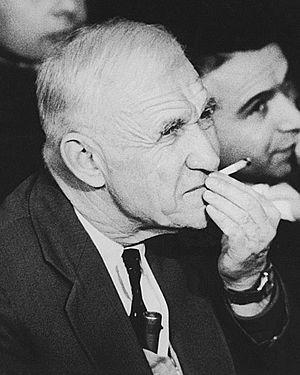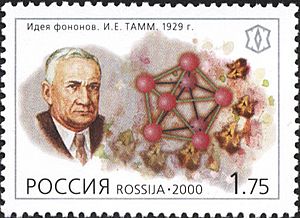Igor Tamm facts for kids
Quick facts for kids
Igor Tamm
|
|
|---|---|

Tamm c. 1958
|
|
| Born |
Igor Yevgenyevich Tamm
8 July 1895 |
| Died | 12 April 1971 (aged 75) |
| Resting place | Novodevichy Cemetery, Moscow |
| Nationality | Soviet Union |
| Alma mater | University of Edinburgh Moscow State University |
| Known for | Tamm states Neutron magnetic moment Cherenkov–Vavilov effect Frank–Tamm formula Tamm–Dancoff approximation Hydrogen bomb Tokamak Phonon Quantum speed limit |
| Awards | 1967 Lomonosov Gold Medal 1958 Nobel Prize in Physics 1954 Order of the Hero of Socialist Labour · Stalin Prize
|
| Scientific career | |
| Fields | Particle physics |
| Institutions |
Second Moscow State University
Moscow State University
Moscow Institute of Physics and Technology
Lebedev Physical Institute |
| Doctoral advisor | Leonid Mandelstam |
| Doctoral students | Vitaly Ginzburg Andrey Sakharov Leonid Keldysh Leonid Brekhovskikh Anatoly Vlasov |
Igor Yevgenyevich Tamm (8 July 1895 – 12 April 1971) was a Soviet physicist. He won the 1958 Nobel Prize in Physics. He shared the award with Pavel Alekseyevich Cherenkov and Ilya Mikhailovich Frank. They won for discovering and explaining Cherenkov radiation in 1934.
Tamm also predicted a type of quasi-particle called a Phonon. In 1951, he and Andrei Sakharov suggested the Tokamak system. This system is used to create clean energy.
Contents
Biography
Igor Tamm was born in Vladivostok, which was part of the Russian Empire. His family had German roots on his father's side. Other sources say he had Jewish ancestry.
He went to a school called a gymnasium in Elisavetgrad, Ukraine. From 1913 to 1914, he studied at the University of Edinburgh in Scotland. His school friend, Boris Hessen, studied there with him.
When World War I started in 1914, he joined the army. He worked as a volunteer medic, helping injured soldiers. In 1917, he joined the revolutionary movement. He was against the war and served on revolutionary committees. After this, he returned to the Moscow State University and finished his studies in 1918.
Tamm married Nataliya Shuyskaya in September 1917. They had two children. Their daughter, Irina, became a chemist. Their son, Evgeny, became an experimental physicist. Evgeny was also a famous mountain climber. He led the Soviet Everest expedition in 1982.
On May 1, 1923, Tamm started teaching physics. He taught at the Second Moscow State University. That same year, he wrote his first scientific paper. It was about how electricity and magnetism work in special materials. In 1928, he visited the University of Leiden in the Netherlands. He became good friends with the famous physicist Paul Dirac. From 1934 until he died in 1971, Tamm led the theoretical physics department. This was at the Lebedev Physical Institute in Moscow.
Key Scientific Discoveries
Surface States
In 1932, Tamm published an important paper. He suggested the idea of "surface states." These are special energy levels that electrons can have on the surface of a material. This idea is very important for how modern electronics work. It helps us understand devices like MOSFETs, which are used in computers and phones.
Neutron Magnetic Moment
In 1934, Tamm and Semen Altshuller made an interesting suggestion. They thought that the neutron might have a tiny magnetic field. This was surprising because neutrons have no electric charge. People at the time thought that only charged particles could have a magnetic field. Later, their idea was proven correct.
Meson Forces
Also in 1934, Tamm came up with another idea. He suggested that the forces between protons and neutrons inside an atom happen through an exchange of tiny, unknown particles. This idea was later developed further by Hideki Yukawa. He called these particles "mesons." This helped explain how the strong force holds atomic nuclei together.
Tamm-Dancoff Approximation
In 1945, Tamm developed a special way to solve problems in physics. This method helps scientists understand systems with many tiny particles. Another physicist, Sidney Dancoff, developed a similar method later. So, it is now called the Tamm-Dancoff approximation.
Cherenkov Radiation
Igor Tamm won the Nobel Prize in Physics in 1958. He shared it with Pavel Cherenkov and Ilya Frank. They won for discovering and explaining Cherenkov radiation. This is a special kind of blue light. It is given off when charged particles move faster than light can travel through a material. It's like a "sonic boom" for light. This discovery has many uses, for example, in detecting particles.
Hydrogen Bomb Project
In the late 1940s and early 1950s, Tamm was part of the Soviet thermonuclear bomb project. He spent a lot of time in a secret city called Sarov. There, he led a group of scientists working on the hydrogen bomb. After the first successful test of the hydrogen bomb in 1953, he left the project. He returned to his work at the Lebedev Physical Institute in Moscow.
Tokamak System
In 1951, Igor Tamm and Andrei Sakharov proposed the tokamak system. A tokamak is a machine designed to create controlled thermonuclear fusion. This means trying to get energy from the same process that powers the Sun. It uses strong magnetic fields to hold very hot gas, called plasma. In 1968, a Soviet tokamak called T-3 showed amazing results. It reached very high temperatures, much higher than other scientists expected. This made scientists around the world excited about tokamaks. Today, tokamaks are still the main type of machine used to research fusion energy.
Later Life and Legacy
In 1964, Tamm became a member of the German Academy of Sciences Leopoldina. He was a student of Leonid Isaakovich Mandelshtam, who influenced his scientific work and life. Igor Tamm was an atheist.
Igor Tamm died in Moscow, Soviet Union on April 12, 1971. A crater on the Moon is named Tamm in his honor. He is buried in the Novodevichy Cemetery in Moscow.
Images for kids
See also
 In Spanish: Ígor Tam para niños
In Spanish: Ígor Tam para niños





